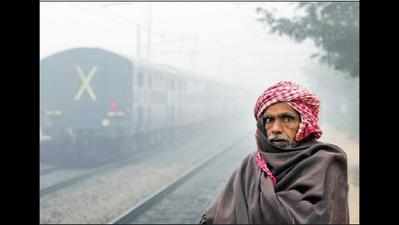- News
- City News
- varanasi News
- Diwali revelry: Varanasi choked, sky covered with smog
Trending
This story is from November 3, 2016
Diwali revelry: Varanasi choked, sky covered with smog
The temple city's air pollution levels reached alarming levels following the celebrations on the day after Diwali, and enveloped the city in a thick cover of smog.

VARANASI: The temple city's air pollution levels reached alarming levels following the celebrations on the day after Diwali, and enveloped the city in a thick cover of smog.
As per the figures revealed by Care4Air, a campaign by Whistle Blower Trust, the level of particulate matter in the air on Monday was 15-20 times more than the level set by the Central Pollution Control Board (CPCB).
Talking to reporters on Wednesday, chief campaigner of Care4Air, Ekta Shekhar said "Pollution levels were monitored with the help of a real time monitoring mechanism at as many as 13 places across the city, the morning after Diwali. The air quality was found highly toxic and has triggered concerns about public health. The device was jointly prepared by IndiaSpend and experts of IIT-Kanpur."
As per their monitoring mechanism, the ultra pollutant, PM 2.5 (particles that measure less than 2.5 microns in diameter), breached the standard by over 20 times at Sonarpura crossing. The levels of PM 2.5 and PM 10 were recorded to be 990 and 687.9 micrograms per cubic metres respectively. The prescribed standard for PM 2.5 is 60 while for PM 10, which is slightly bigger than PM 2.5 but very harmful for the respiratory system, is 100. Burning of firecrackers and burning of waste in open air were held responsible for the rise in air pollution in Varanasi.
Shekhar said, "According to CPCB's findings, air pollution was marginally higher than last year as PM 2.5 and PM 10 ranged between 380 micrograms per cubic metre and 341 micrograms per cubic metre, while last year (November 12, 2015), it was recorded at 305 and 256 micrograms per cubic metre respectively".
"On Monday morning, Varanasi woke up to a highly polluted air, as smoke from Diwali fireworks, coupled with moisture and nearly stagnant wind movement, shrouded the city in a thick cover of smog at a time when the vehicular emission was minimal," she said, adding that air samples at tourist places like Sarnath, too, was alarmingly high with PM 2.5 and 10 being recorded at 463 and 419 micrograms per cubic metre respectively while Chowk area recorded lowest pollution levels.
City-based pulmonologist and physician, Dr. RN Vajpayee, said "Prolonged exposure to PM 2.5 and PM 10 can harm the respiratory system as the ultra fine particulates can find their way deep into the lungs and also enter the bloodstream". He said that the volume of sulphur dioxide (SO2), which can aggravate asthma, also breached safe standards, indicating that the crackers contained a high level of sulphur.
As per the figures revealed by Care4Air, a campaign by Whistle Blower Trust, the level of particulate matter in the air on Monday was 15-20 times more than the level set by the Central Pollution Control Board (CPCB).
Talking to reporters on Wednesday, chief campaigner of Care4Air, Ekta Shekhar said "Pollution levels were monitored with the help of a real time monitoring mechanism at as many as 13 places across the city, the morning after Diwali. The air quality was found highly toxic and has triggered concerns about public health. The device was jointly prepared by IndiaSpend and experts of IIT-Kanpur."
As per their monitoring mechanism, the ultra pollutant, PM 2.5 (particles that measure less than 2.5 microns in diameter), breached the standard by over 20 times at Sonarpura crossing. The levels of PM 2.5 and PM 10 were recorded to be 990 and 687.9 micrograms per cubic metres respectively. The prescribed standard for PM 2.5 is 60 while for PM 10, which is slightly bigger than PM 2.5 but very harmful for the respiratory system, is 100. Burning of firecrackers and burning of waste in open air were held responsible for the rise in air pollution in Varanasi.
Many other areas including the densely populated Godowlia crossing and Lanka had nearly similar readings between 6-10am on October 31 morning, when vehicular pollution was minimal.
Shekhar said, "According to CPCB's findings, air pollution was marginally higher than last year as PM 2.5 and PM 10 ranged between 380 micrograms per cubic metre and 341 micrograms per cubic metre, while last year (November 12, 2015), it was recorded at 305 and 256 micrograms per cubic metre respectively".
"On Monday morning, Varanasi woke up to a highly polluted air, as smoke from Diwali fireworks, coupled with moisture and nearly stagnant wind movement, shrouded the city in a thick cover of smog at a time when the vehicular emission was minimal," she said, adding that air samples at tourist places like Sarnath, too, was alarmingly high with PM 2.5 and 10 being recorded at 463 and 419 micrograms per cubic metre respectively while Chowk area recorded lowest pollution levels.
City-based pulmonologist and physician, Dr. RN Vajpayee, said "Prolonged exposure to PM 2.5 and PM 10 can harm the respiratory system as the ultra fine particulates can find their way deep into the lungs and also enter the bloodstream". He said that the volume of sulphur dioxide (SO2), which can aggravate asthma, also breached safe standards, indicating that the crackers contained a high level of sulphur.
End of Article
FOLLOW US ON SOCIAL MEDIA










